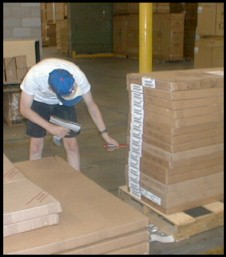
Goodbye to organized confusionDistribution and shipping system lauded by furniture company for its profitabilityNo more hide-and-go-seek at Hooker Furniture. The Martinsville, Virginia-based company just upgraded its shipping and distribution system to streamline its operations. And it's a big success. A few years ago, Hooker Furniture, a $225-million-a-year case goods business, installed a company-wide client/server computer network with a real-time information system to support its five shipping/distribution centers. "A subsequent study of our shipping/distribution facilities revealed how successful the high-tech system was working at sites spread throughout North Carolina and Virginia," explained Talmage Fish, vice president of Information Services at Hooker Furniture. "It also showed we needed to centralize and consolidate the distribution centers for increased efficiency." In November 1998, the firm purchased a 400,000-square-foot facility near a smaller shipping facility in Martinville, Virginia. They once again contracted with Compsee to provide the computer integration services and hardware, including cabling, bar code labels, and a radio frequency data communication network, just as Compsee had done earlier for the original five distribution centers. "We decided to use Symbol Technologies Spectrum 2.4 networking technology on the RF system," said Fish. That included the PDT 6840 portable data collection terminal, VCR 3940 vehicle-mounted terminals, and the LS 3200 long-range scanners. "They will scan from a couple of feet to 18-20 feet," said Lee Pickler, director of technical services at Compsee. Compsee did the site survey to determine where the radio frequency access points were needed for 100% coverage when transmitting from an RF terminal. Compsee then coupled those RF access points with network and power connections and fans, and enclosed it all in a NEMA 12 safety-rated casing. The national systems solutions firm also provided network equipment, fiber patch panels for fiber optic connection, the network hubs, wiring closets, and the Ethernet network for the facility. CMD Systems from Charlotte, NC, a Deloitte-Touche subsidiary, provided the warehouse management software plus the General Data software package, Data Logger Gold, for data collection in the hand-held and forklift-mounted terminals. Compsee also assisted in configuration of the terminals, helped install the software and connected the system to an NT Server, making sure Hooker had connectivity to its Hooker Shipping/Distribution System, said Pickler. "We also provided terminal installation on several different models of fork lifts," Pickler added. The BenefitsBy March 1999, the newly acquired distribution center was operating at full speed and full capacity. "That particular month, we had record shipments," noted Fish. "It was a start-up month, we were training employees, installing computers, RF systems, you name it. And it really came through for us." For example:
With increased employee productivity, the ability to ship faster, and all but eliminating inaccuracies, the high-tech data installation has given Hooker Furniture a tremendous advantage over its competition. "We have minimized over and under shipments. I would estimate our productivity has increased 20% to 30% easily. Shipping accuracy has to be at 99% plus," said Fish. And yet more benefits"With the start-up of the new distribution center, we had the first true locator system we'd had in the company's history," said Fish. No more "lost" furniture gathering dust in a corner of the warehouse. With the information available via the RF system, "our employees easily determine where a shipment is located, should there be a customer inquiry." Warehouse management can tell accurately and effectively where everything is located. And workers know immediately where to put items for storage and where to pick items for shipment. As a result, those employees are big fans of the high-tech installation. No more search- and-rescue furniture detail. "When they (employees) go to pick items for shipment, the screen tells them where the items are located. This really enhances their productivity. We accomplish more work per shift in any given day because of the accuracy of the system," said Fish. He said the entire shipping process improved with the paperless RF system. "It's a real-time operating system," said Fish. "Transactions are readily visible at all networked workstations in the company. Basically, customer service, traffic, and shipping are on view for all employees at any location. Information is updated every minute of every hour." With the improved accuracy of its shipping and receiving functions, Hooker Furniture introduced cycle counting and plans to eliminate the physical counting of inventory, normally done twice per year, said Fish. The ProcessThe employee-owned company imports about 25% of its products, with the balance manufactured domestically. It manufactures home office and household furniture, with the largest product lines in the entertainment and home office segments. Hooker now ships all of the case goods furniture from various satellite plants to one of the two distribution facilities in Martinville. Each carton of furniture has an internal code containing the unit's serial number. The serial number tracks it from the manufacturer to the customer, and all stops in between, said Fish. "We know which serial number is on which product and was sent to which customer. The system constantly tracks each item," he said. When the product leaves the manufacturing plant, each case's internal bar code label is scanned onto a truck, initiating Hooker's warehouse management software program to create an internal bill of lading. That information is immediately sent over Hooker's client/server network to the distribution facility, which then knows when the product will arrive and what items are coming.
"Once we make sure we received everything the plant shipped, then we can cross dock if we need it for immediate shipment," said Fish. The dock locations are bar coded too, so as a case is forklifted to the dock, it is again scanned. If instead the case goes into storage, the bar-coded bin storage site is scanned. "Our computer system tracks which items we have and which bins they are in. We scan on receiving, put-away or crossdocking," summarized Fish. Picking and shipping ordersWhen orders are released from Hooker's traffic department to the distribution center, a pick list and bar-coded shipping labels are printed. The shipping label uses UCC 128 symbology-an American Furniture Manufacturers Association standard that also meets VICS EDI standards, said Fish. This is used to track the case as it moves from the shipping dock to the retail outlet. The bar code shipping label has a unique Serialized Shipping Container Code (SSCC) that will never be used again. The forklift operator takes that pick list and shipping labels and goes to the designated location for each item. There he scans the station and the item, then takes it to the staging area and scans a location bar code label there as well. Another operator takes the previously printed UCC 128 bar code shipping labels and applies the wrap-around labels to the case or carton of furniture. Another operator scans items onto the truck. "If we don't scan the same 10 items on the truck that were picked for the load, we won't be able to close out the order and send the shipment," warned Fish. For example, added Fish, one operator picked 10 and tried to load eight. The shipping mode was stopped in its tracks to alert the operator of the error. "We simply did not have that check and balance in the manual shipping system," said Fish. "After the shipment is closed and ready to roll, and if it is destined for one of our major retail customers, the computer automatically initiates an advance ship notice (ASN), automatically transferring the appropriate data from the Hooker Furniture warehouse management application to the customer's via electronic data interchange (EDI). It tells the customer when the order left, by which carrier, and what the shipment contains. "When the customer receives the shipment, they have the ASN in their system. All they have to do is scan the SSCC code on each case. If it balances, then we are ready to do electronic invoicing," said Fish. "Because the customer knows ahead of time when our truck will arrive and what the contents are, they can adjust the schedule for their unloading crews and other employees. It saves the customer time and expense, as well." With the automated system, Hooker Furniture can do a complete EDI business cycle from purchase order to invoicing if required. "That's eliminated the faxing of manifests and bills of lading, and an overwhelming amount of paperwork involved with the ASN," said Fish. "But the true proof of the RF system's success, said Fish, is Hooker Furniture decided to add another 200,000 square feet to the purchased distribution facility that isn't even a year old." It's obvious, the order and productivity brought by the RF-based shipping and receiving system has this furniture company hooked on high tech for speed, accuracy and bigger profits. |
top
Home | The Company | Systems Solutions | Products & Pricing
Software & Support | Reseller Resources | Contact Compsee
 Once
the truck gets to the distribution center, each case is scanned
as it comes off the truck. The warehouse management software program
then checks what did arrive against what was shipped from the
manufacturing plant.
Once
the truck gets to the distribution center, each case is scanned
as it comes off the truck. The warehouse management software program
then checks what did arrive against what was shipped from the
manufacturing plant.